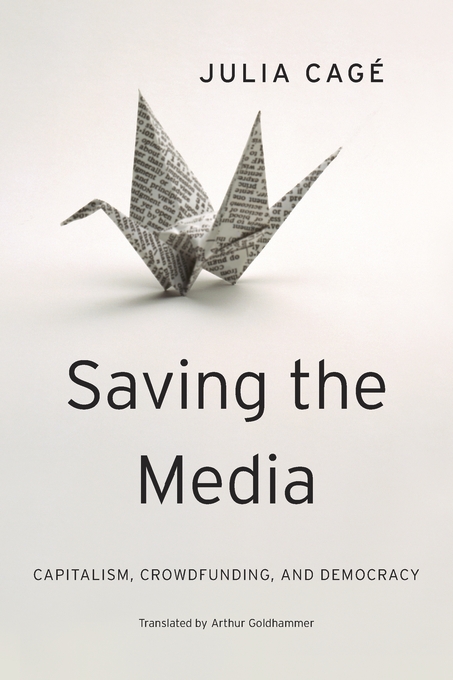Julia Cagé is an economics professor at Sciences Po Paris. This month (April, 2016), her book, “Saving the Media: Capitalism, Crowdfunding and Democracy,” was published in English translation by an imprint of the Harvard University Press. This Q-and-A interview was conducted April 22, 2016 by Bill Densmore, director of the Information Trust Exchange project. Email: julia.cage@sciencespo.fr

Q: What problems does your book outline for the media industry?
A: The industry faces two problems today: The first is loss of profits (mainly because of decrease in advertising revenues) combined with race for higher profits.
The second is problem is who will support journalists and journalism?
Papers have reacted to decline in revenues by decreasing the size of the newsroom (even when they were still making profits!). The have expected journalists to write 2-4 articles a day. They have closed foreign bureaus.
Q: So what solutions appear to you?
A: The first place we need to go is nonprofit. I don’t think media outlets should lose money, they should make enough money to survive but shouldn’t aim at making a lot of money. Nonprofit status is part of the solution.
But beyond that, we have to disconnect in our mind the capital issue and control issue. That’s the core proposal in my book, “Saving the Media.” In a sense it is a way to raise enough money from readers and journalists to run a paper. To have a 10-15 journalist newsroom, you need $2M to $5M Euros. And you can’t find that. So we need outside stakeholders or donors to bring in more money.
Q: Is there anything close to this approach in existence?
In France there are examples owned by either public or journalists. But as soon as they were looking for outside money they had to open to outside shareholders and that ends the co-operative. In France if you look at Le Monde until 2010 the main shareholders were the society of journalists and readers and they were the main shareholders and it worked, but they needed to find more money and investors took majority share.
You can also look at Google, which has two classes of stock with a 10:1 variation in voting rights between the company’s founders, and other shareholders. We need to put both these concepts together:
- Readers and journalists as shareholders in a co-operative way
- Capital shares with no — or greatly reduced — voting rights
If I were to do it concretely tomorrow that would be the simple way to do it. If you want to buy more than a certain number of capital shares than you buy shares with reduced voting rights. They wouldn’t invest to make money; this is a nonprofit model.
Q: How might your suggest about ownership that splits between capital and other stakeholders affect journalism?
A: Jeff Bezos didn’t buy The Washington Post to make money. His hiring of many more journalists and testing of the network with other U.S. papers have been great. But there is a looming issue of journalism independence.
The tycoons of the past, what they cared about in the past was to make presidents — politics. I think Jeff Bezos, he does not care about politics, what he cares about is regulation. To him it is as good to have a Democratic or Republican president, as long as the power given to him by the Washington Post is enough to impede regulation. And I think that is a big danger.
It is fair to say the quality of Washington Post journalism has increased. But the coverage of the ecommerce issues is in question. I think there is a lot of journalism self-censorship. There is a new owner, so they prefer to just not talk about ecommerce.
I am doing systematic research now: From which sectors do owners of journalism organizations make a share of their revenue and to what extent does it affect their coverage of those areas.
Q: What do you see as the error being made by publishers?
A: Right now online groups are spending most of their time figuring out how to share advertising revenues with Facebook and make more short-term money. There is an issue with ad blockers. They are looking to find new ways to do advertising that will not be blocked by ad blockers. Native advertising is not the way to go because it is a way to not be honest with the reader. The obsession of owners is to find the most efficient way to advertise. That is true in the short run. But this is not true in the long run because in the long run the same thing will happen, when all media outlets do advertising the same way, the price will decrease.
Q: What would you do if you were a quality publisher?
A: I would put up a paywall. I would be willing to lose money for 2-3 years. The time for you to have enough revenues to compensate for the initial decrease in advertising is 2-3 years. I would be willing to lose money in the short run betting that increasing the I have worked with a lot of media outlets that have made the choice – paywalls and no advertising. The shock is stronger in the United States which has been more dependent on advertising.
This won’t work for sites with low-quality content. They will have to try to survive in an increasingly competitive, programmatic advertising environment where CPMs keep going down. But for them it is not too much of a problem because they produce at very low cost — they made the choice of copy/paste rather than invest in quality journalism.
For high-quality content, the opportunity is to focus on the segment of the audience that itself focuses on quality. These are the new players. When we were living with just print journalism legacy media outlets faced with this challenge, they had to make this choice of quality with a paywall or mass-market without, or to offer something different online.
Q: The Reynolds Journalism Institute is working with quality publishers and a technology non-profit to develop a privacy-by-design ethical ad network that only tracks users by anonymous interest cohorts and is governed by a nonprofit, the Information Trust Exchange Governing Association (ITEGA). http://www.infotrust.org
A: In a sense it would be a way to say to high-quality site consumers we need some advertising revenue, but those advertisers are going to behave in a fair way so you don’t have to use an ad blocker. It makes a very good sense. I see very well how you can convince high quality media. I see the advantage for high-quality media outlets but not the low-quality websites. Also, don’t advertisers track individually because they think they make more money from it?
Q: What do you think about payment systems such as Blendle?
CAGE: I don’t think Blendle or any payment system should be done on a global scale by one entity because then the technology platform has too much control. I would like to see system that work within individual countries at the national level.
Q: What if there were one technology approach, governed by a globally-focused nonprofit like the ITEGA, but which allows subnetworks within countries?
CAGE: That would make sense.\
Q: what do you think is the relationship between user privacy and ad blocking?
A: As to privacy: This issues of cookies is not only because they are bored with tracking, It is because they are really worried about privacy. You would need to convince them that you are going to collect a lot of information but not use it directly. Everything is anonymized, you are using just for statistics. That will be the hardest part is to convince them that at this point you are asking for more but at the end of the day you are going to use less. You have to convince people that they are not sacrificing their privacy.
Q: Does your research indicate that privacy is the reason for ad-blocking installation?
A: I don’t have formal research on this point. But I spend a lot of time talking to students, in my classes and about three quarters have blockers and one major concern is about privacy. Privacy may not be the main reason but it is definitely a factor.
Q: My impression is that when people first become aware of retargeting – ads that follow your individual action – that is when they become concerned about privacy.
A: Yes. It is like Orwell’s 1984 — the impression that someone is looking at what they are doing. Advertisers think this is efficient, but people are so afraid of it today that it is not turning out therefore to be efficient.
Q: What is the source of your optimism that people will pay for quality information?
If you look at the business newspapers. If works. If you look at the New York Times, they tried twice, the first time it was failure, but today all of the growth in revenues is online subscriptions. If you look at the only more or less, the single general information French media outlets today, more or less only one was created in 2007 with a paywall — Mediapart in France – is very successful.
In defining success, the main problem is everyone is misunderstanding the statistics.
They are wanting to compare number of online subscribers with their total audience online. But all the people online never bought their newspaper before. The public you should try to reach is the people who were subscribing to the print newspaper and in fact you want to get them subscribing online instead. And the production cost is lower, so you need a lower number of subscribers than before.
Q: But aren’t there really two audiences for newspapers – the people who once subscribed in print but have dropped it as well as those – especially millennials – who consume a lot of news – online – but have never had a relationship with a print newspaper or magazine?
A: The main issue with digital natives is from the beginning we have given them high-quality news for free. We never asked them to pay. We always gave them everything for free. I think we need to ask them to pay. You won’t reach 100% of this generation. You need to reach perhaps 10% or 15% and you need to convince them to buy an online subscription and you need to provide them with something that is different. You won’t get them by asking to pay for something the can get for free.
You also need to do it with digital multimedia support that they like – videos and such. You cannot reach them if you are just putting online things in the same format as you do offline. Because they are used to consuming news in a different way. From this point of view The Economist is doing a great job. They do incredible things on their website. We have to cynch the way we produce information online. Newspapers will have to invent 3D online to convince young people to pay online. This will be the future of the news. They will not consume it the same way we did.

